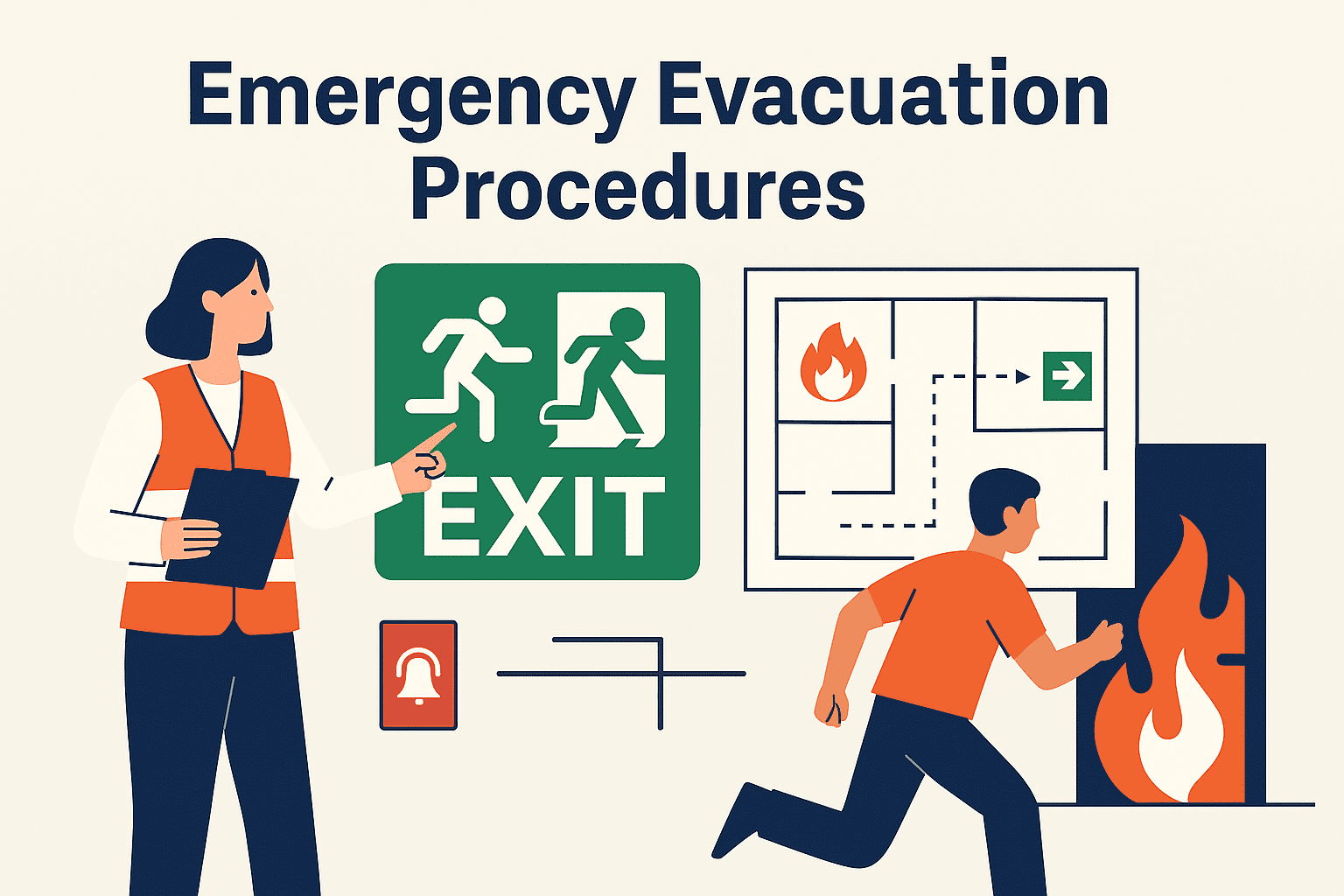
Emergency Evacuation Procedures – Step-by-Step Workplace Guide
Emergencies can strike anytime — from fires and chemical spills to natural disasters and workplace violence. A well-prepared workplace with a clear, practiced, and compliant emergency evacuation procedure can save lives and reduce chaos when disaster strikes.
This article provides a comprehensive step-by-step guide to designing, implementing, and maintaining effective Emergency Evacuation Procedures for any workplace, based on global best practices and OSHA standards.
1. What Are Emergency Evacuation Procedures?
Emergency Evacuation Procedures are formal, documented instructions that outline how employees should exit a building or work area quickly and safely in response to emergencies. These procedures are a core part of an organization’s emergency preparedness plan.
They include:
- Identification of potential hazards requiring evacuation
- Clear evacuation routes and exits
- Roles and responsibilities during evacuation
- Communication protocols
- Drill schedules for practice and evaluation
2. Importance of Having Proper Evacuation Procedures
A well-developed evacuation plan is essential because:
- It saves lives during emergencies.
- Minimizes injuries by providing clear, practiced routes.
- Meets legal requirements such as OSHA 29 CFR 1910.38.
- Protects assets by enabling rapid hazard control.
- Improves employee confidence in safety measures.
3. Common Workplace Emergencies Requiring Evacuation
Workplaces may face different risks depending on location, industry, and operations. Typical triggers for evacuation include:
- Fires (electrical, chemical, structural)
- Gas leaks or toxic vapors
- Chemical spills
- Explosions
- Earthquakes
- Floods and storms
- Workplace violence or active shooter incidents
- Bomb threats
4. Step-by-Step Guide to Emergency Evacuation Procedures
Step 1: Risk Assessment
- Identify hazards specific to the workplace.
- Conduct fire risk assessments and chemical hazard analyses.
- Assess building layout for evacuation challenges.
Step 2: Design Evacuation Routes
- Create at least two exits from each work area.
- Mark routes clearly with illuminated signs.
- Ensure routes are free from obstruction.
- Install emergency lighting in all corridors and stairwells.
Step 3: Assign Roles and Responsibilities
- Evacuation Wardens – Direct people to exits.
- First Aid Responders – Provide medical assistance.
- Searchers – Ensure all employees have evacuated.
- Head Counter – Confirm all persons are accounted for at assembly points.
Step 4: Establish Communication Protocols
- Use alarms (audible and visual) to alert staff.
- Consider PA systems or mass text alerts.
- Pre-assign signals for different emergencies.
Step 5: Designate Assembly Points
- Located a safe distance from the building.
- Large enough to accommodate all employees.
- Clearly marked and known to everyone.
Step 6: Special Provisions for Vulnerable Persons
- Assign a buddy system for persons with disabilities.
- Provide evacuation chairs for multi-story buildings.
- Train staff on assisting individuals with mobility impairments.
Step 7: Document the Plan
- Written procedures accessible to all employees.
- Include maps, contact numbers, and step-by-step actions.
Step 8: Conduct Regular Drills
- At least twice a year (OSHA recommendation).
- Evaluate response time and identify areas for improvement.
Step 9: Review and Update
- After every drill or real emergency, review what worked and what didn’t.
- Update routes and roles if there are workplace changes.
5. Roles & Responsibilities During an Evacuation
| Role | Responsibility |
|---|---|
| Employees | Follow evacuation routes, do not collect belongings, move calmly to assembly point |
| Supervisors | Ensure team members are accounted for and safe |
| Evacuation Wardens | Guide and assist employees, check all rooms |
| First Aid Responders | Provide emergency medical aid |
| Security Personnel | Prevent unauthorized re-entry |
| Management | Activate emergency plan, liaise with emergency services |
6. Key Safety Tips During an Evacuation
- Never use elevators during fire emergencies.
- Stay low to avoid smoke inhalation.
- Close doors behind you to slow the spread of fire.
- Avoid re-entering the building until cleared by emergency services.
7. Legal Requirements and Standards
- OSHA 29 CFR 1910.38 – Emergency Action Plans
- NFPA 101 Life Safety Code – Exit and egress requirements
- ISO 45001 – Occupational health and safety management
8. Common Mistakes to Avoid
- Not practicing the evacuation plan.
- Blocking exit routes with furniture or stock.
- Not considering employees with disabilities.
- Failing to update the plan when workplace changes occur.
9. Emergency Evacuation Checklist
Below is a sample checklist to ensure your workplace is ready:
| Item | Status (Yes/No) |
|---|---|
| Evacuation routes clearly marked | |
| Fire alarms tested and functional | |
| Emergency lighting operational | |
| Assembly points designated and marked | |
| Evacuation maps posted | |
| Employees trained on procedures | |
| Drills conducted in last 6 months | |
| Contact list of emergency services available | |
| Buddy system for persons with disabilities in place | |
| Plan reviewed within last 12 months |
10. Conclusion
An effective Emergency Evacuation Procedure is not just a legal requirement — it’s a lifesaving protocol. By assessing risks, defining roles, training employees, and practicing regularly, your workplace will be ready to respond calmly and effectively to any emergency.
Remember: In an emergency, confusion kills. Preparation saves lives.
External Link: OSHA Evacuation Plans and Procedures eTool
Confined Space Entry Procedure – Roles, Responsibilities, and Safety Measures
Incident Reporting and Investigation Procedures – Best Practices
Lockout and Tagout – LOTO Safety Procedure
How to Perform a Fire Risk Assessment in the Workplace – Step-by-Step Guide






















